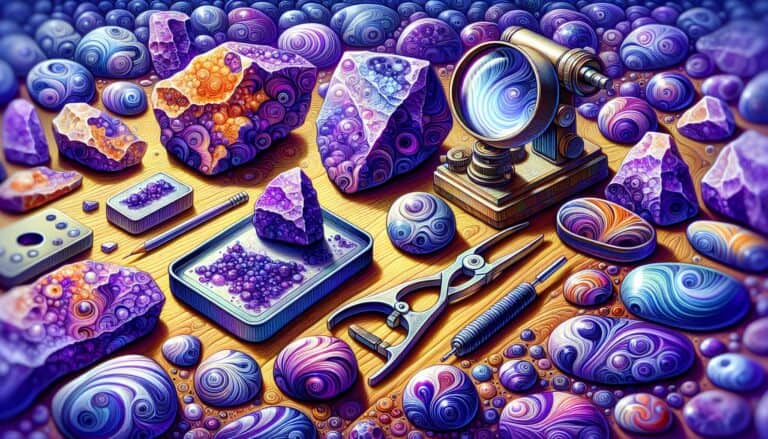Discovering the vibrant world of minerals, you’ve likely stumbled upon apatite, a gemstone beloved for its array of colors and uses.
But how can you be sure that the stone in your hand is truly apatite? Identifying it accurately is key to appreciating its true value and beauty.
Identification can be tricky, but with the right know-how, you’ll be distinguishing apatite like a pro. From its unique colors and crystal forms to its hardness and specific gravity, certain characteristics make apatite stand out.
Let’s dive into the essentials of spotting this gem among the stones.
To identify apatite, observe its color range and hexagonal crystal shape. Perform a streak test for a white streak, ensure it’s non-magnetic, and check its hardness (5-6 on Mohs scale). Apatite is doubly refractive and has a specific gravity of 3.1 to 3.2, distinguishing it from similar minerals.
How to Identify Apatite Through Testing
When you’re faced with a stone and wonder if it’s apatite, there are a variety of tests that can help you confirm its identity. These simple yet effective methods are used by professionals and hobbyists alike to pinpoint the gemstone’s unique properties.
Visual Inspection
Start with a thorough Visual Inspection. Observe the stone’s color range, from greens and blues to yellows and sometimes purples. Apatite often displays a hexagonal crystal shape, setting it apart from other minerals. Inspect the surface for any visible scratches since apatite has a Mohs hardness rating of 5, making it susceptible to abrasions.
The Streak Test
Perform the streak test by rubbing the stone against unglazed porcelain and examine the color of the streak it leaves behind. Apatite typically leaves a white streak, which can be a quick indicator of its presence. Remember, the softer apatite won’t scratch some materials, so a faint streak may form.
Magnet Test
Use a magnet to see if the stone is magnetic. Apatite is not magnetically responsive, so if the stone attracts the magnet, it’s not apatite.
Hardness Test
The Hardness Test helps distinguish apatite from other minerals. With a hardness of 5 on the Mohs scale, apatite can be scratched by a knife but can scratch glass. If your stone resists scratching glass or is easily scratched with a coin, it’s likely not apatite.
Birefringence Test
Examine the stone under polarized light to observe birefringence – a phenomenon where a double image appears due to light splitting into two paths when passing through the stone. This characteristic is a strong indicator of apatite.
Checking The Diaphaneity
Apatite’s diaphaneity ranges from transparent to translucent. Hold the stone up to a light and observe how much light passes through. This’ll give you a clue about the stone but keep in mind, it’s not definitive.
Single or Double Refraction
Assess whether the stone shows Single or Double Refraction. Apatite is typically doubly refractive, meaning when you look through it, images appear doubled. This can be observed with a loupe or magnification tool.
Refractive Index Test
For greater accuracy, perform a Refractive Index Test using a refractometer. Apatite’s refractive index usually ranges between 1.632 and 1.42. This test provides a more precise identification but requires specialized equipment.
Finding The Specific Gravity
The specific gravity of a mineral is a telltale sign of its identity. Apatite’s specific gravity ranges between 3.1 to 3.2. You can measure this by weighing the mineral in air and then in water to calculate its density.
Identifying Apatites in the Field
In the field, look for apatite in igneous, sedimentary, and metamorphic rocks, particularly in areas known for phosphate deposits. Take note of the stone’s associations with other minerals, like quartz or feldspar, which can be a sign of apatite.
Recognizing Potential Apatite Rocks
Potential apatite-containing rocks are generally lighter due to the lower density of apatite compared to other gemstones. These rocks might also show signs of phosphorescence or “glow” under UV light – another characteristic feature of apatite.
By applying these methods, you’ll be armed with the knowledge to identify apatite accurately. Remember, practice makes perfect, and over time, you’ll develop an instinct for recognizing this versatile gemstone.
Physical Characteristics of Apatite

Diving into the physical characteristics, apatite stands out due to its unique features. Generally, the gems are translucent to opaque, offering you a clue about their identity. The color spectrum of apatite is quite broad, with common hues including green, blue, yellow, and sometimes even violet. You’ll find that these colors can range from vibrant to pastel, adding to the difficulty of a straightforward identification.
When inspecting these stones, take note of their crystal system. Apatite crystals are typically hexagonal, meaning you’re looking for a six-sided shape. This is a distinguishing characteristic that sets apatite apart from minerals with similar coloration or transparency. The hexagonal prisms are often well-formed, making them relatively easy to spot with a keen eye.
The Mohs hardness of apatite falls around 5, which means they can be scratched by objects with a higher hardness rating. This fact adds to the identification process as it narrows down the possibilities. Understanding the basic scratch test will help you leverage this characteristic effectively.
Another physical property to observe is the gem’s luster. Apatite possesses a vitreous luster, giving it a glass-like sheen that is quite noticeable. When held to the light, a piece of apatite should reflect light in a way that’s reminiscent of a glass surface. Remember, while apatite is commonly confused with beryl or tourmaline due to similar lusters, its distinct hexagonal shape and hardness can help you differentiate it.
How Are Apatite Formed?
Apatite, a phosphate mineral, is often a byproduct of geological processes that involve igneous, sedimentary, and metamorphic rocks. Understanding its formation is key to identifying apatite-like specimens in various environments.
In igneous rocks, apatite crystals form during the cooling process of molten magma. The mineral crystallizes from phosphate-rich magmas, making it a common accessory mineral in these rocks. Apatite grains in igneous rocks tend to be small but can be identified by their distinctive color and shape.
Sedimentary apatite forms through two primary pathways: from the deposition of organic matter or the direct precipitation from phosphate-rich water. Bones and teeth of vertebrate animals are major contributors to phosphate sediments that can later form apatite. Alternatively, apatite can precipitate out of water in marine environments when conditions, such as temperature and pH, trigger the concentration of phosphate compounds to reach a point where apatite begins to crystallize.
When considering metamorphic rocks, apatite forms due to the recrystallization of phosphate during the intense heat and pressure changes that these rocks undergo. This can result in apatite with improved clarity and size, making such specimens particularly desirable.
Notably, the presence of fluorine, chlorine, or hydroxide ions can lead to the formation of various apatite group minerals, with distinct chemical compositions and properties. These differences may affect their transparency, color, and even their utility in different applications. Remember, while identifying apatite, it’s crucial to consider the geological context of the rock in which you find it.
Preparation for Apatite Hunting
Before embarking on your hunt for apatite, it’s essential to prepare adequately to ensure a successful and safe adventure. Adequate preparation involves assembling the right tools and considering safety measures to protect yourself during the search.
Gathering the Right Tools
When you’re setting out to find apatite, having the appropriate tools can make the difference between a fruitful search and coming home empty-handed. Here’s a list of the essentials:
- Geologist’s hammer: to extract samples from rocks
- Chisel and gloves: to split rocks safely
- Sturdy bag or backpack: to carry your findings and tools
- Hand lens or magnifier: to examine specimens on-site
- Maps of the area: to navigate and locate potential apatite deposits
- GPS device or compass: for precise location tracking
Remember, the quality of your tools can greatly influence your ability to correctly identify and extract apatite. Invest in durable materials that can withstand rugged geological environments.
Safety Considerations
Your safety should always be a top priority. Apatite hunting often takes place in outdoor, unpredictable environments, therefore, it’s critical to take precautions:
- Wear protective gear: This includes safety glasses, gloves, and a hard hat to prevent injury from flying rock fragments.
- Dress appropriately: Choose clothing that’s suitable for the terrain and weather conditions you expect to encounter.
- Stay aware of your surroundings: Look out for potential hazards like wildlife, poisonous plants, or unstable ground.
- Inform someone of your plans: Always let a friend or family member know where you’re going and when you expect to return.
- Bring a first aid kit: Be prepared to handle minor injuries in case of an accident.
By focusing on these safety aspects, you can reduce the risks associated with apatite hunting and increase the enjoyment of your mineral collecting experience.
Handling and Care of Found Apatite

After successfully identifying apatite, it’s essential to know how to manage your newfound gemstones properly. Handling and care are critical to preserving apatite’s natural beauty and maintaining its value. From cleaning to storage, every step you take should aim to protect the integrity of the gemstone. With a Mohs hardness rating of 5, apatite isn’t the most durable of minerals, so gentle care is obligatory.
Cleaning Apatites
To keep apatite’s luster radiant and its colors vibrant, you’ll want to employ proper cleaning techniques:
- Use a soft, lint-free cloth for wiping away any loose dirt or debris.
- Mix a solution of mild soap with lukewarm water to gently clean your apatite.
- Soak the stone for a short duration, as prolonged exposure can weaken it.
- Refrain from using harsh chemical cleaners or abrasive materials that could scratch the surface of your apatite.
- After cleaning, carefully rinse your apatite with cool water to remove any soap residue.
- Pat your apatite dry with a soft towel and lay it out to air dry completely before storing or wearing it.
It’s vital to treat your apatite with care during the cleaning process. Avoid high-pressure water jets or steam cleaners as the heat and force can potentially cause damage.
Storing Apatites
Proper storage of your apatite ensures its longevity and protects it from potential harm:
- Wrap individual apatite stones in soft cloths or place them in fabric-lined jewelry boxes to prevent scratches.
- Keep apatite away from harder gemstones that could scratch its surface.
- Store apatite in a cool, dry place away from direct sunlight, which could fade its vibrant colors over time.
- Separate your apatite from jewelry pieces that could entangle with it, potentially causing breakage or chipping.
Remember that apatite is sensitive to heat, acids, and alkaline solutions. Its storage environment should reflect this sensitivity to ensure the gemstone doesn’t degrade over time.
By adhering to these cleaning and storing guidelines, you’re helping to preserve the beauty and integrity of your apatite for years to come. Handling apatite might require a bit of extra attention, but the vibrant colors and unique properties of this gemstone make it well worth the effort.
Conclusion: Confirming Apatite is Real
You’ve now got the tools to confidently identify apatite and ensure that your gemstone retains its allure over time.
Remember, the key to preserving apatite’s charm is in the care you provide. Stick to the gentle cleaning methods and heed the storage advice to protect your stone’s integrity. By treating apatite with the attention it requires, you’ll enjoy its vibrant colors and unique properties for years to come.
Keep these tips in mind and your apatite will continue to be a treasured piece of your collection.




![Alabama Rockhounding Sites in [year]: Fossil & Mineral Spots](https://observationhobbies.com/wp-content/uploads/2024/01/SHOqOO3B-QS16Lqks0Ax9-768x439.jpg)


